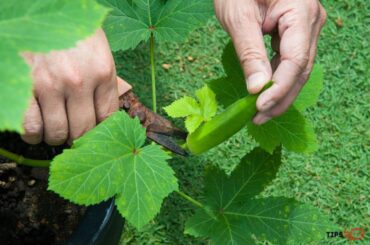Do pothos plants need drainage? For plant parents, addressing the moisture requirements of plants is one of the most tremendous tasks that they have to frequently face.
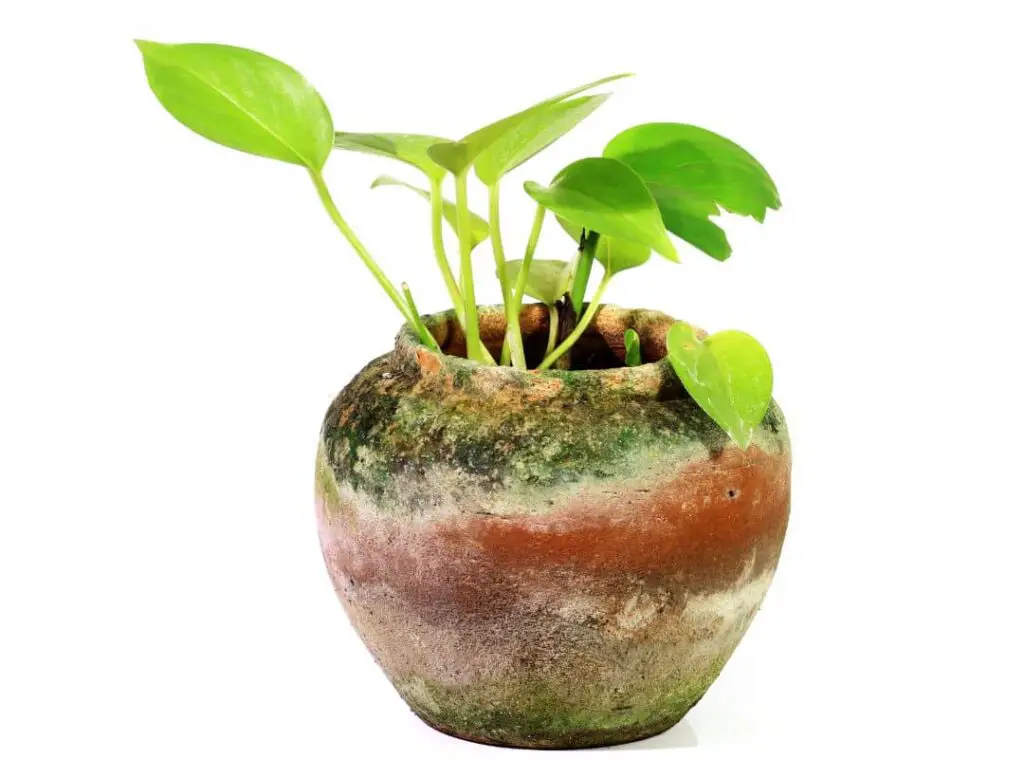
The same as too little, too much water for plants is detrimental. As a caring plant parent, if you’re looking for a guide to satisfy the moisture needs of your pothos plants, then, this article is for you.
Pothos (Epipremnum aureum), also known as Devil’s vine, Ceylon creeper, Ivy arum, Taro vine, and Silver vine is one of the easiest houseplants to have in your home. They don’t produce flowers, but their heart-shaped, evergreen foliage gives your home a wonderful tropical texture.
You can grow pothos with a bit of neglect as they have the ability to thrive in relatively hard settings. Interestingly, these tropical vines are perfect for growing indoors not only for their aesthetic appearance but also for their potential to improve indoor air quality by absorbing hazardous airborne contaminants.
Do Pothos plants need drainage?
In brief, yes, pothos, just like other plants, need drainage to thrive. Particularly, potted pothos plants do not prefer to take root in soil with stagnating water since it can cause many health problems.
When growing in the wild, pothos plants don’t need artificial drainage as the water on the floor dries up quickly. But, once you grow them in pots, you should provide them with adequate drainage to get the best performance from your plants.
Pothos have the potential to thrive in relatively dry soil due to the presence of aerial roots. Along with the buried roots in the soil, the aerial roots of pothos also take up moisture from their surroundings to quench their thirst.
As a matter of fact, though the plant is watered a little, it will survive in a damp environment. Keep in mind that this does not imply that you should not water or that you should water too less for your pothos plants at all.
The plants will suffer if they grow in an arid ambient environment with too little water at the same time.
Similarly, these creepers can survive in relatively damp areas too. However, problems will arise if they are exposed to too much water for a prolonged period of time.
So, no matter whether pothos grow indoors or outdoors, when pothos grow especially in pots, you have to make sure that there is sufficient drainage. Otherwise, waterlogged soil resulting from poor drainage will cause severe issues that affect your plants’ health.
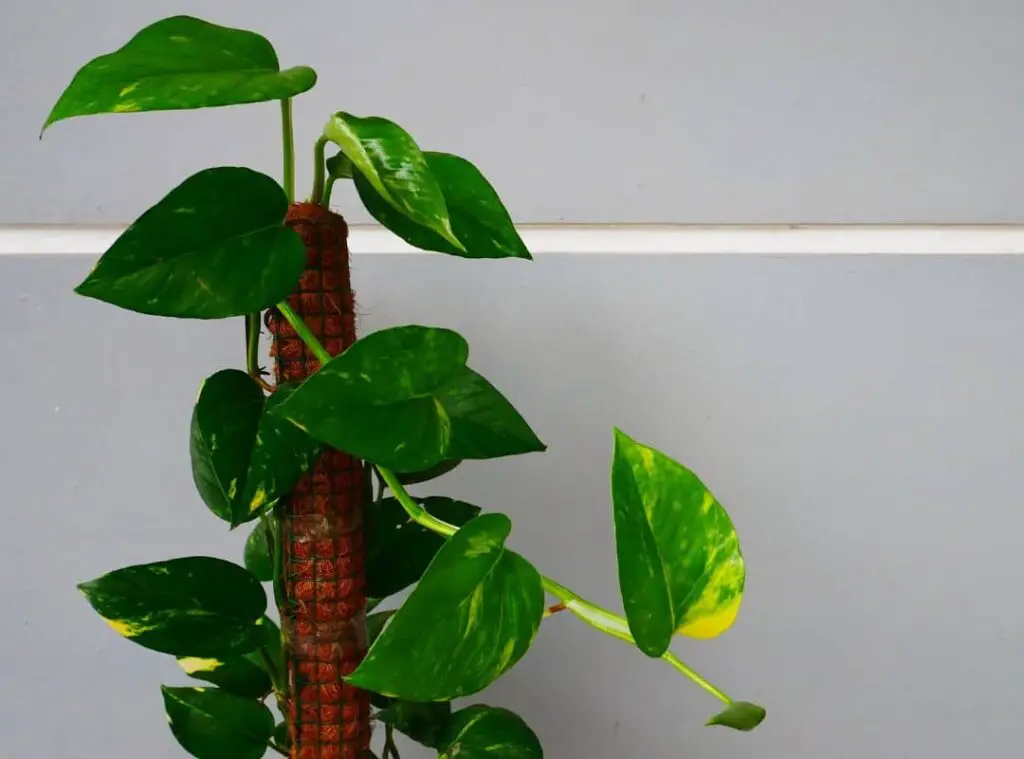
Why do they need drainage?
Lack of drainage for potted pothos makes the potting medium oversaturated. If this happens, there will definitely be consequences that are unpleasant to deal with.
Root rot is the most common and most severe issue that is likely to occur due to excess water and poor drainage for the plants. When pothos plants sit in soggy soil for long, the roots begin to suffocate. Since the oxygen supply for the roots declined, the roots will start to die and decay.
Further, if the roots of the plants rot, they will no longer be able to absorb water and nutrients that are crucial for the vitality of the plant. Thus, the plants retard their growth and eventually die unless you take immediate measures to protect them.
Moreover, inadequate drainage leads to plants becoming less attractive. Pothos are delicate plants due to their lush green foliage. Unfortunately, poor drainage can cause the eye-catching green color of the foliage to fade, turning the leaves’ color to yellow or brown.
Another problem linked with improper drainage is the risk of salt build-up in the soil. If there is no sufficient drainage for potted pothos, salt build-ups are not unusual. Due to insufficient drainage, minerals in tap water and fertilizers can be trapped in the soil. Over time, these salt build-ups can hurt the plants.
Therefore, make sure that both the soil and the pot you’re going to use for your pothos plants encourage adequate drainage to keep the plants healthy.
How to provide good drainage?
Obviously, providing the right drainage for the pothos is not a difficult task. You can do this in several ways.
Use free-draining soil
There is no doubt that the soil where the plant is growing plays a significant role in plant health. Most plants, including pothos, benefit from well draining soil. The soil should not remain soggy between waterings.
This will ensure that the roots absorb the right amounts of moisture and nutrients required for the plants. Soggy soil discourages the roots from absorbing nutrients and the gas exchange between the soil and the roots.
Typically, the use of clay soil solely for pothos is not recommended as they do not drain well. Instead, try to use loam soil for pothos.
Use soil additives
To achieve proper drainage, you can mix certain materials into the soil that you’re going to use for pothos. The addition of organic materials such as compost and livestock manure improves the free draining from the soil.
Just add a few handfuls of organic materials or, if not, some perlite with the soil to make your soil drain fast enough.
Add a layer of gravel to the bottom of the pot
This helps prevent the potting media from blocking the drain holes. Over time, the soil in the pot can become compact and dense. This can clog the holes of the pot and prevent free drainage. You can solve the problem by putting a layer of stone on the bottom of the pot before planting the pothos.
Select a pot with drainage holes
The pot also equally contributes to the plants’ performance. Thus, the selection of a pot that allows proper drainage is important. A pot with holes or slits at the bottom is ideal to improve draining. In addition, pay attention to the size of the pot too.
Because, if the pot is too large for your plant, it will hold more water than the plant actually needs, making room for an unhealthy plant. Further, if the pot is too small, the growth of the pothos will be hindered.
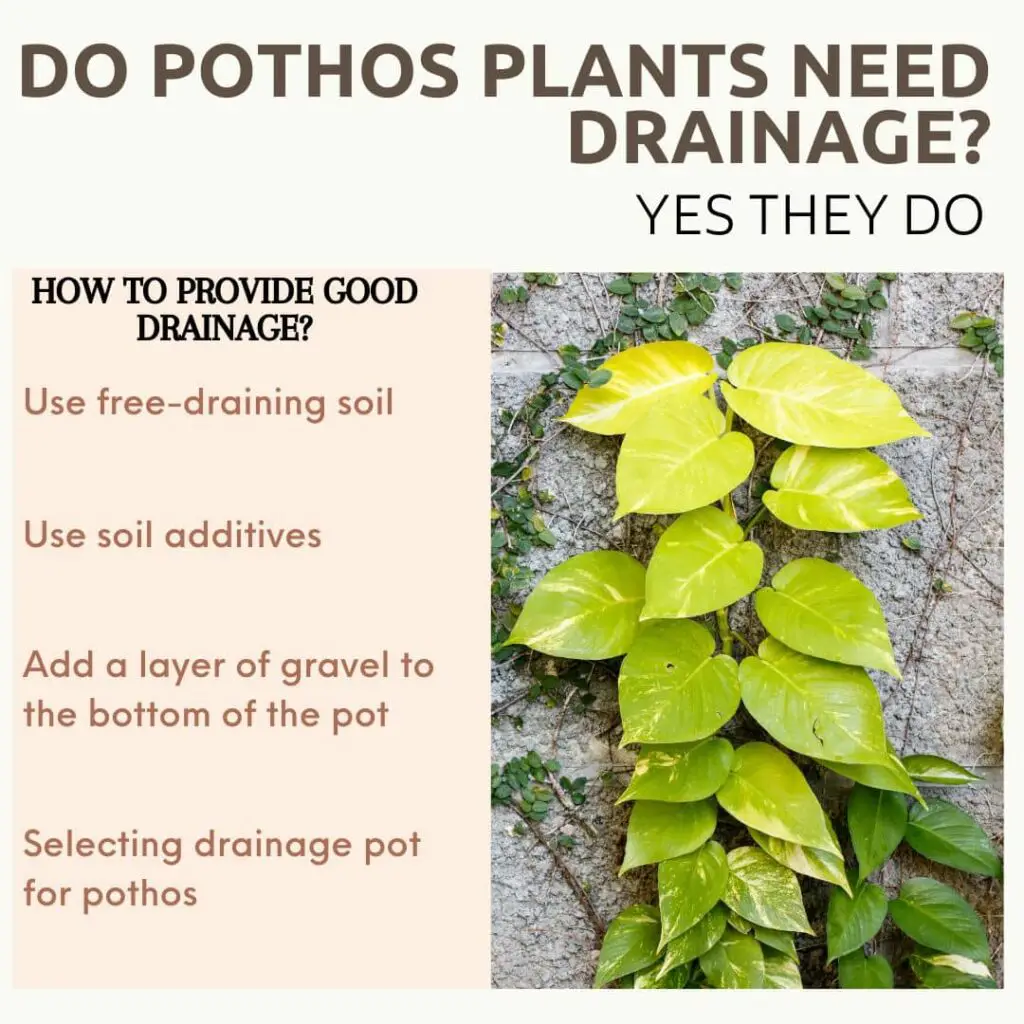
Selecting drainage pot for pothos
Choosing the right pot for a pothos plant is not complicated and at the same time can be overwhelming too. You’re free to pick any pot material (ceramic, fiberglass, plastic, terracotta, etc.) for pothos, but make sure to select the right size pot with drainage holes.
A pot with a good drainage hole is crucial because if you overwater the plants, it will protect your plants by draining excess water, so the plant might be less susceptible to diseases.
A pot with a permanent saucer is not suitable to use for pothos. With a permanent saucer, the removal of overflow can be difficult. Alternatively, it will be better if the saucer is detachable. So, you can empty the overflow on the saucer as necessary to keep the plant happy and healthy.
How do you water pothos without drainage holes?
If you’re interested in using decorative pots with no drainage holes, no worries! You can still use them for growing pothos! There are a couple of things that you can do to prevent problems related to too much water for the plants.
If the pot is large enough, you can use a pot liner, or you can plant the pothos plant in a pot with a drainage hole and place it inside the decorative pot with no drainage holes. When watering, you can take the small pot out and water the plant directly. Let the water drain enough and then place the pot again inside the large pot.
Apart from that, you can add a layer of gravel to the bottom of the pot so the overflow will move to the space with the gravel rather than remain in the soil. Thereby, you can prevent the plant roots from sitting in overly saturated soil for an extended period of time.
A word of caution: The major problem with decorative pots with no drainage holes is that sometimes you might be overly careful when watering and tend to give the plant less water than the plant actually needs. If this happens, the foliage will be wilted and dehydrated.
Therefore, you should be vigilant that your plants are getting enough water to promote healthy growth.
How do you know if a pothos needs water?
When it comes to irrigation, it is crucial to water pothos when the soil becomes partially dry. Practically, the moisture requirement of the plant varies with the environmental conditions such as temperature, humidity, and airflow.
At high ambient temperatures and low levels of humidity, plants need relatively much water. If you notice the leaves of pothos plants start to wilt, it indicates that you should water them quickly. However, this doesn’t mean that you have to wait until the foliage gets wilted to water your plants.
There is a simple tip to determine when you should water pothos plants. Just dip your finger about one to two inches into the soil and feel the dampness in the soil. If you feel the soil is still wet, probably it’s not the time to water the plants. But if the soil is dry, you should water your plants.
Whenever possible, water your plants early in the morning. It helps dry the soil during the daytime. So, the chance to expose the roots to wet soil is minimal.
Do Pothos like self-watering pots?
Clearly, pothos grow well in self-watering pots. If you’re a busy plant parent with no time to check the water needs of the plants routinely or if you forget to water your plants, then the use of self-watering pots is the best option for you.
Self-watering pots draw a sufficient amount of water into the soil from the reservoir without making the soil overly damp. Thus, you may not worry about diseases like root rot if you use such pots for the pothos.
Anyway, do not forget to check the water level of the reservoir. Make sure to refill it if the water level is too low in order to ensure the plants have constant access to water.
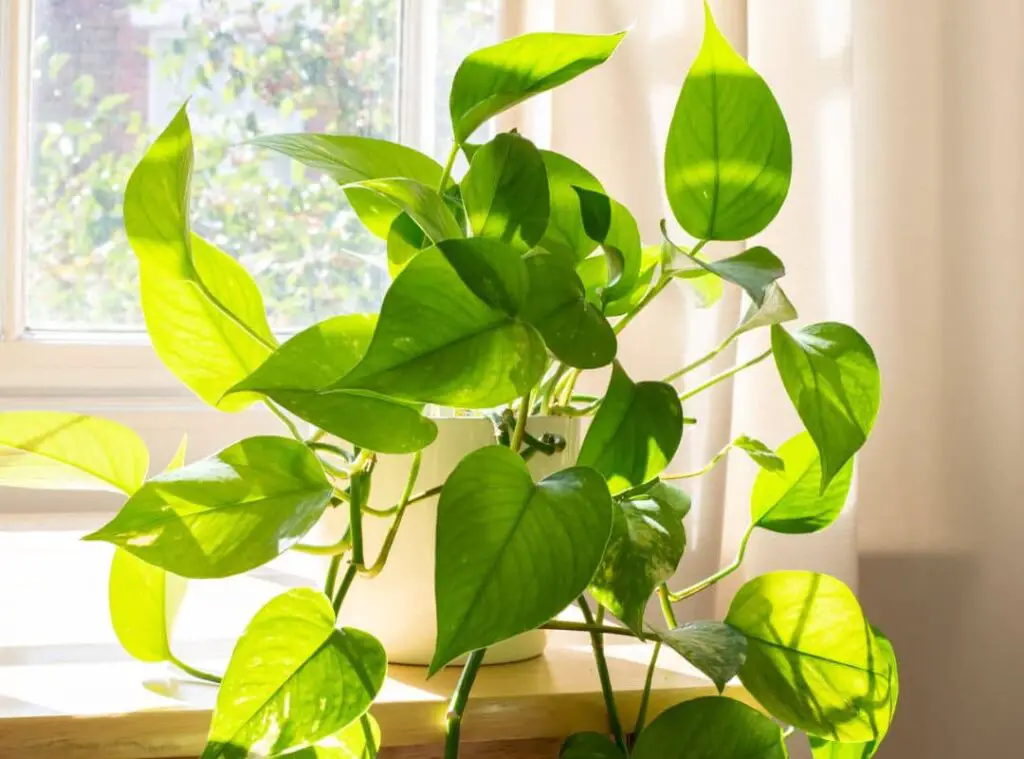
Can you overwater a Pothos?
The most straightforward answer is no. You should never overwater pothos for many reasons. As mentioned already, if you keep exceeding the moisture requirement of the pothos plants, they will suffer consequently.
Due to too much water in the soil, the soil may not hold enough oxygen for the roots, leading to their death. Further, due to the invasion of pathogenic soil microbes, and the inability to absorb adequate nutrients from the soil, the plant will stunt its growth and it will die eventually.
Remember that watering too much causes more harm to the plant than watering too little.
How often do you water Pothos in summer?
You can see the active growth of pothos plants apparently during the summer months. So, to favor optimal growth, provision of the right level of water is essential. Due to the high temperature and arid ambient conditions, you may need to water pothos 2-3 times per week during the summer.
But generally, this is not a fixed time schedule to water for pothos. It is good to check the moisture level in the soil at least twice or thrice a week and water pothos when the soil is partially dry.
How do you save Overwatered Pothos?
If you suspect that pothos plants have been sitting for too long, there are a few things you can do to save your plants. However, the extent of the damage that occurred to the plant will determine the due treatment.
If you accidentally overwater pothos, allow excess water to escape. Be sure drainage holes do their function well. If not, expose the pot to the sun until you feel the excess moisture has been removed from the soil. You can limit watering the plant for several days or a week as necessary.
But if you notice the signs of root rot, such as yellowing of leaves, wilting of leaves, drooping of leaves early, and so on do not let your plant sit in the same soil any longer. Remove the plant carefully from the pot. Trim off the unhealthy roots from the plant.
Use a clean sterile pruning blade to trim the roots. It is advisable to sterilize the blade after each cut to prevent the spreading of the disease to healthy roots of the plant. You can rub some alcohol or Lysol solution on the blade to make it sterile. Once you get rid of rotten roots, replant your pothos in new soil.
If the plant is severely affected by the disease, select some healthy parts of the vine with aerial roots and separate them from the mother plant. Dip them in water until they develop new roots. you can plant these materials in new pots.
Recently asked questions
Should I spray water on my Pothos?
Misting is especially beneficial to pothos plants during the hot seasons.Once the ambient environment is dry, plants lose much water through transpiration. It will make the plants’ condition worse when the soil holds less water at the same time. In such a scenario, you can boost the growth of your plants simply by spraying water (misting) on them.
Misting increases the humidity around the plant. This allows the plants to absorb enough moisture from their surroundings. Further, because of the damp ambient environment, the plant will lose less water via transpiration, so plants will stay flourished.
Why are my pothos drooping?
There are several reasons for the drooping of pothos leaves, including overwatering, underwatering, direct exposure to the strong sun, disease conditions, and less humidity.
Underwatering, overwatering, and disease conditions like root rot lead the plant to absorb a little water. When there is no sufficient water for the pothos, it will be difficult to maintain their vigor. As a result, drooping can happen.
Similarly, when too much water is removed from the plants due to an arid environment or exposure to the harsh sun again dropping is possible.
Why are the tips of my pothos leaves turning brown?
Usually, the tips of pothos leaves can turn brown due to improper watering (overwatering or underwatering). Once the roots die because of overwatering practices, the leaves start to fade their color to brown.
Here, the plants may longer be capable of maintaining the desired color due to the degradation of color pigments. Other than that, unmasking to the direct sun, diseases, too much fertilizer, and pest attacks are the potential causes for the browning of pothos leaves.
Conclusion
Do Pothos Plants Need Drainage? For pothos, providing adequate drainage where the plants get accommodated is essential for the plants to thrive.
As long as you give enough drainage for pothos, it is easy to remove excess water leaving no room for diseases, maintaining good airflow around the root zone, and flushing the excess salts away from the soil to keep plants healthy. keep in mind that a healthy plant always comes from healthy roots.
Thus, along with the other requirements of the plants, try to provide the best substrate for them with the right level of moisture.
Read Next : 24 Hardy Plants That Don’t Need Drainage Holes


